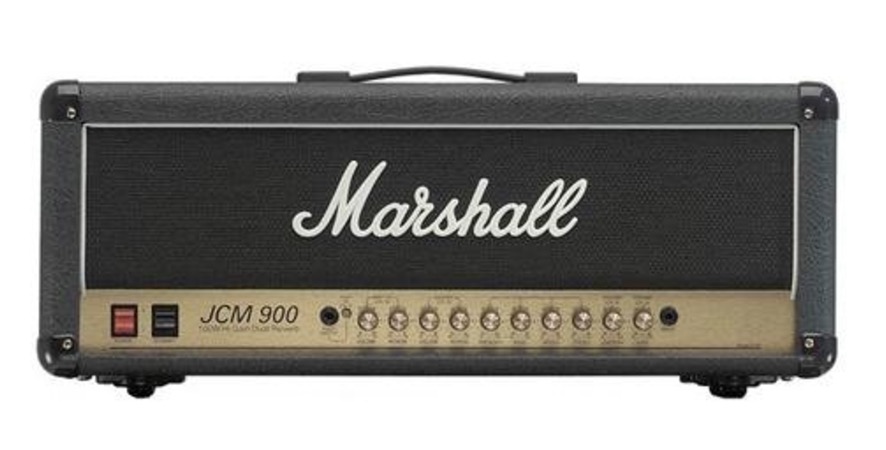Marshall JCM900 4100 Review
by Dave Fox
Marshall’s JCM series of amps has got to be one of the most legendary designs to ever grace the world of music. JCM800 laid down the groundwork for what was supposed to be an ever-evolving family of powerful tube heads.
However, in an odd twist of faith, JCM800 lived to become ‘the’ JCM. It’s successor, the JCM900 wasn’t so lucky. A few quirks in the original 900 series has marked the entire line of amps.

This unfavorable reputation is something that follows them even to this day. The question is whether or not Marshall JCM900 is a bad amp?
Well, Dave Navarro certainly doesn’t think so. After all, he has two he is pretty close with. Today we are going to review this least favorable JCM and show you why it still has a lot to offer.
Marshall JCM900 4100
From a distance, JCM900 looks more or less just like any other JCM head. However, this is a significantly different beast compared to its predecessor.
Marshall wanted to spice the series up a bit by offering the user more gain. It is believed that their line of reasoning behind this decision was to give the people more of what made the initial JCM so popular.
Even when 900 series hit the market, Marshall’s heavy OD sections were already well known.
Features
The core of the are its two ECC83s in the preamp stage and one ECC83 combined with four 5881 tubes in the power stage. These power two separate channels and are capable of delivering some 100 Watts of power.
On paper, this setup looks pretty amazing on its own. However, it was soon discovered that replacing the 5881s with a set of good old EL34s can really add a lot to the performance of any JCM900. More on that later.
The aesthetics are pretty familiar. Marshall mostly changed things on the inside, retaining the exterior of the existing JCM series to a certain extent. Speaking of design, this thing is a tank.
It’s heavy, it’s merciless and simply built very well. Same goes for the inside. Every connection, solder, lead – all of them are done properly. Marshall might sometimes gamble with the performance their amps, but durability is never brought into question.
A brief look at the control panel reveals a nonstandard Marshall layout. You have the Master and Reverb knobs for both Channel A and Channel B in their individual clusters.
Up next comes the Presence control that is followed by the three band EQ section.
Lastly, there are pre-amp gain knobs for each channel. On their own, these controls are pretty much all you need to dial in a variety of rich guitar tones.
Add the fully integrated FX loop and you end up with the standard Marshall configuration that has proven to work so many times so far.
When you look at the back side of the amp, there is a more or less standard I/O section with adjustable speaker outputs as well as the FX loop send/return ports.
Marshall left the back semi-open, with only a metal mesh separating the outside world from the tubes inside. Lastly, the footswitch comes as standard, which is to be expected from a head in this range.

Performance
This is where things get a bit tricky. Earlier models of the JCM900 felt like an unfinished product the moment they first appeared. You had constant diode clipping to deal with, on top of the seemingly underpowered 5881 tubes inside.
Later iterations of JCM900 ironed out a lot of those problems, however, damage was already done at that point. This is pretty unfortunate considering how capable recent JCM900 heads really are.
Right out of the box, you get a whole lot of gain to work with. Marshall specifically focused on infusing more power into the signal, thus making the overdrive channel reach the levels of distortion quite easy.
There is a catch, though. Cleans took a substantial hit because of all this. You no longer had that recognizable Marshall purity at your disposal. Instead, quality of the clean channel was sacrificed for more gain.
This is what divided most of the community. Those looking for a balanced, all-purpose amplifier were pretty disappointed with this latest JCM. On the other hand, those who were chasing the ultimate valve distortion were loving every bit of the 900 series.
One of the earlier solutions to this problem was to simply take out the 5881s and replace them with a set of trusty EL34 tubes. In most cases, this brought a significant boost in tone quality, but sometimes it simply didn’t work out.
People oriented towards a heavier tone found this trade to be more than acceptable. Dave Navarro is just one popular guitar player who has ditched everything for these amps.
The tone itself is pretty good. There is a lot of power behind it, making it fairly defined. Cleans will generally satisfy most tastes. The main problem is the ‘color’ of the clean channel, or in other words, its flavor.
It stands out from the competition but is fairly versatile. Marshall JCM900 is pretty much already defined by this. Metal fans will do just fine with one, while those chasing a vintage tube tone might end up disappointed.
Conclusion
The entire reason why JCM series amps even exist is because Marshall has decided to change things and defy the mainstream.
JCM 900 was first released during the ’90s. which was a time when the industry was doing their best to catch up with the popular demand.
That demand requested more gain. Whether or not Marshall could have done things better is up for discussion.
The truth is that JCM900 may not be the best thing since sliced bread, especially within the context of the entire JCM family.
However, this head is more than capable. It requires a different approach to tone shaping and some previous planning, but the whole thing is still more than competitive.
The Marshall JCM900 4100 is also featured here:
Related Videos
 |
 |
 |
 |

About Dave Fox
Recorder of many songs, haver of many albums. Dave (AKA Young Coconut) has been making music for the past twenty years or so, of varying genres and degrees of quality, to the dismay of listeners and algorithms everywhere. He’s also in the Suburban Bicycle Gang with Jerry Grey.
Dave has a keen interest in studying all aspects of music history, especially experimental / genres like jazz, krautrock, drum n’ bass, and no wave.
Here’s his Spotify: https://open.spotify.com/artist/1v3iPVEXzurahTI2Tm4Tpm
Leave a Reply
Musical Inspiration
Check for FREE Gifts. Or latest free acoustic guitars from our shop.
Remove Ad block to reveal all the rewards. Once done, hit a button below
 |
 |
 |
 |